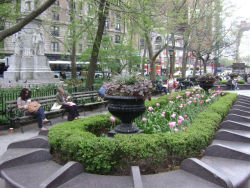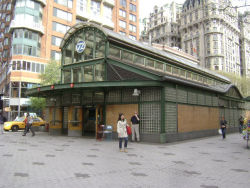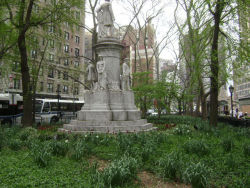Verdi Square
View all monuments in NYC Parks, as well as temporary public art installations on our NYC Public Art Map and Guide.
Giuseppe Verdi
| Artist: | Pasquale Civiletti |
| Dedicated: | October 11, 1906 |
| Location: | Broadway at 73rd Street |
Artwork History
Giuseppe Fortunino Francesco Verdi (1813–1901), one of the world’s most renowned composers, is immortalized by such operas as Aida, La Traviata, Otello, and Rigoletto, which are still performed regularly to great acclaim. This legacy is also captured in the Verdi Monument, created by Sicilian sculptor Pasquale Civiletti (1858–1952) in 1906. Made of Carrara marble and Montechiaro limestone, this statue depicts Verdi flanked by four of his most popular characters: Falstaff, Leonora of La Forza del Destino, Aida, and Otello.
Verdi was born in Le Roncole, Italy, on October 10, 1813. Denied entrance in 1832 to the renowned Conservatory in Milan, he was privately schooled and became the municipal musical director of Busseto in 1834. In 1839 his first opera, Oberto, was produced at the famous La Scala opera house in Milan. He went on to compose more than twenty operas, as well as other choral works and the Messa da Requiem (1874). Verdi was also a benefactor of many charitable causes, including a working-class farm, a hospital, and an old-age home for musicians. He died on January 27, 1901. Having attained almost mythic status during his lifetime, Verdi was instrumental in further developing opera into an integrated art form of drama and music.
The president of the Verdi Monument Committee, Carlo Barsotti (1850–1927), championed public recognition of pre-eminent Italians as a source of inspiration for New York’s large Italian-American community. As founder and editor of Il Progresso Italo Americano, he used his newspaper to raise funds for this project by public subscription. Barsotti was instrumental in erecting this monument as well as those honoring Christopher Columbus (1892) in Columbus Circle, Giuseppe Garibaldi (1888) in Washington Square Park, Giovanni da Verazzano (1909) and Dante Alighieri (1921) in Dante Square.
The Verdi monument was unveiled on October 12, 1906, the 414th anniversary of Columbus’s discovery of America. The day began with a march of Italian societies from Washington Square to the site at Broadway and West 72nd Street. Over 10,000 people attended the unveiling, attesting to the significance of the occasion in uniting Italian-Americans in celebration of their cultural and artistic heritage. The sculptures were unveiled by Barsotti’s grandchild who pulled a string that released a helium balloon, lifting the monument’s red, white and green shroud (the colors of the Italian flag). As it peeled away, a dozen doves - concealed in its folds - were released into the air, and flowers cascaded from the veil upon the participants.
By the 1930s the monument had suffered from the effects of weathering, pollution and vandalism, and underwent restoration, including the replacement of sculptural features. In 1974, Verdi Square was designated a Scenic Landmark by the Landmarks Preservation Commission, one of only eight public parks to receive this distinction. In 1996-97, the monument was again extensively conserved with funding from the Broadway/72nd Street Associates.
A permanent monument maintenance endowment has been established by Bertolli USA, Inc. Additional funds for landscaping designed by Lynden Miller have been donated by Harry B. Fleetwood, and the Verdi Square landscape has been endowed in memory of musician James H. Fleetwood.
Artwork Details
| Description: | Statues on ped., surrounding statues |
| Materials: | Carrara, Monte Chiaro limestone |
| Dimensions: | H: 25'9" Diameter: 18' |
| Donor: | Resident Italians |
Please note, the NAME field includes a primary designation as well as alternate namingsoften in common or popular usage. The DEDICATED field refers to the most recent dedication, most often, butnot necessarily the original dedication date. If the monument did not have a formal dedication, the yearlisted reflects the date of installation.
For more information, please contact Art & Antiquities at (212) 360-8163.
Check out your park's Vital Signs
Clean & Safe
Green & Resilient
Empowered & Engaged Users
Share your feedback or learn more about how this park is part of a
Vital Park System




